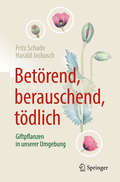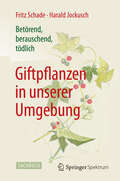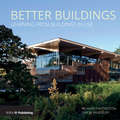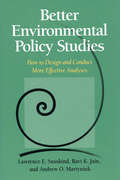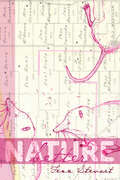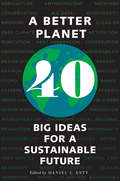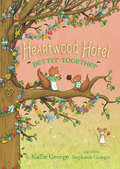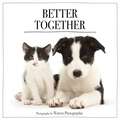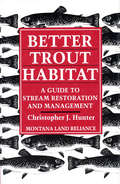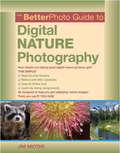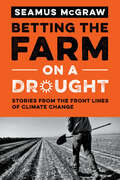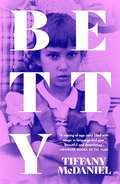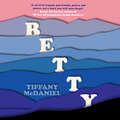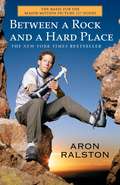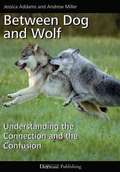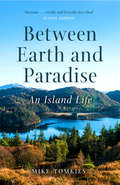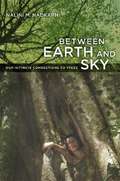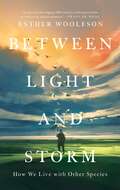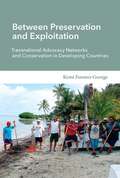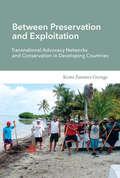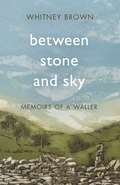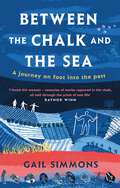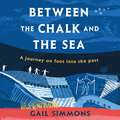- Table View
- List View
Betörend, berauschend, tödlich - Giftpflanzen in unserer Umgebung
by Fritz Schade Harald JockuschWussten Sie dass durch Honig schon mal eine Schlacht entschieden wurde? dass sich das Reinheitsgebot für Bier ursprünglich gegen eine einheimische Rauschgiftpflanze gerichtet hat? dass der Wunderbaum Palma Christi ein Eiweiß produziert, das im deutschen Kriegswaffenkontrollgesetz aufgeführt wird? wieviele Pflanzen in Ihrem Hausgarten und in Parks giftig sind? Antworten auf viele spannende Fragen wie diese liefert das Giftpflanzenbuch von Fritz Schade und Harald Jockusch. Der Künstler Schade hat Giftpflanzen nach der Natur mit Farbstiften porträtiert, der Biologe Jockusch informiert über botanische, biochemische und toxikologische Fakten. Die Darstellungen werden durch historische Rückblicke, Anekdoten und eigene Erfahrungen aufgelockert. Im Buch folgt die Anordnung der Arten in etwa der jahreszeitlichen Abfolge des ersten Auftretens auffälliger giftiger Pflanzenteile. Wie die üblichen, mit Fotografien bebilderten Giftpflanzenratgeber dient ihr Buch der Gefahrenvermeidung, betont aber auch das Anschauungs- und Lesevergnügen.Die künstlerischen Darstellungen in diesem Buch verbinden ästhetischen Reiz mit hohem Wiedererkennungswert. Sie können leichter verinnerlicht werden als detailreiche Fotografien. Das gilt vor allem für Kinder, die durch Giftpflanzen besonders gefährdet sind. Neben der blühenden wird die fruchtende Pflanze dargestellt, wenn dies für die Vergiftungsgefahr relevant ist. In die 2. Auflage wurden 12 neue Pflanzenarten aufgenommen, von denen einige derzeit die Öffentlichkeit beschäftigen.
Betörend, berauschend, tödlich - Giftpflanzen in unserer Umgebung
by Fritz Schade Harald JockuschWussten Siedass durch Honig schon mal eine Schlacht entschieden wurde?dass sich das Reinheitsgebot für Bier ursprünglich gegen eine einheimische Rauschgiftpflanze gerichtet hat? dass der Wunderbaum Palma Christi ein Eiweiß produziert, das im deutschen Kriegswaffenkontrollgesetz aufgeführt wird?wie bezaubernd schön viele Giftpflanzen sind?Antworten auf viele spannende Fragen wie diese liefert das Giftpflanzenbuch von Fritz Schade und Harald Jockusch. Der Künstler Schade hat Giftpflanzen nach der Natur mit Farbstiften porträtiert, der Biologe Jockusch hat Fachwissen und Anekdotisches aus Gegenwart und Geschichte zu diesen Pflanzen zusammengestellt. Wie die üblichen, mit Fotografien bebilderten Giftpflanzenratgeber dient ihr Buch der Gefahrenvermeidung, betont aber auch das Anschauungs- und Lesevergnügen. Die Autoren beleuchten botanische, biochemische, historische und anekdotische Zusammenhänge für jede Pflanzenart und informieren so auf unterhaltsame Weise. Im Buch folgt die Anordnung der Arten in etwa der jahreszeitlichen Abfolge des ersten Auftretens auffälliger giftiger Pflanzenteile.Die künstlerischen Darstellungen in diesem Buch verbinden ästhetischen Reiz mit hohem Wiedererkennungswert. Sie können leichter verinnerlicht werden als detailreiche Fotografien. Das gilt vor allem für Kinder, die durch Giftpflanzen besonders gefährdet sind. Neben der blühenden wird die fruchtende Pflanze dargestellt, wenn dies für die Vergiftungsgefahr relevant ist.
Better Buildings: Learning from Buildings in Use
by Richard Partington Simon BradburyThis book started life as a successor to Sustainable Architecture, published in 2007, which set out to prove that sustainable architecture can indeed both ‘lift the spirit’ as well as save the planet. This fully revised edition seeks to take a step further, exploring how sustainable buildings are occupied and work, and sheds light on the methods used to observe this. Through short essays from thought-leaders and case studies of visually stunning, environmentally ground-breaking projects, Better Buildings provides architects with the inspiration and tools they need to deliver sustainable design.
Better Environmental Policy Studies: How To Design And Conduct More Effective Analyses
by Lawrence Susskind Ravi K. Jain Andrew O. MartyniukEnvironmental policy studies commissioned by government agencies or other stakeholders can play a vital role in environmental decisionmaking; they provide much-needed insight into policy options and specific recommendations for action. But the results of even the most rigorous studies are frequently misappropriated or misunderstood and are as likely to confuse an issue as they are to clarify it. Better Environmental Policy Studies explores this problem, as it considers the shortcomings of current approaches to policy studies and presents a pragmatic new approach to the subject. Reviewing five cases that are widely regarded as the most effective policy studies to have been conducted in the United States in the last few decades, the authors present a comprehensive guide to the concepts and methods required for conducting effective policy studies. The book: *describes and explains the conventional approach to policy studies and its shortcoming *presents the history, impacts, and common elements of five successful policy studies *offers an in-depth look at the different tools and techniques of policy analysis *extends the concepts and principles of successful policy studies to their potential uses in the international arena Better Environmental Policy Studies presents a practical, battle-tested approach to overcoming the obstacles to formulating effective environmental policy. It is an invaluable resource for students and faculty in departments of environmental studies, public policy and administration, and planning, as well as for professional policy analysts and others involved with making decisions and mediating disputes over environmental issues.
Better Nature
by Fenn StewartMuch of the language that makes up Better Nature—the first poetry collection by writer and academic Fenn Stewart—is drawn from a diary that Walt Whitman wrote while travelling through Canada at the end of the nineteenth century.But rather than waxing poetic about the untouched Great White North, Stewart inlays found materials (early settler archives, news stories, email spam, fundraising for environmental NGOs, and more) to present a unique view of Canada's "pioneering" attitude towards "wilderness"—one that considers deeper issues of the settler appropriation of Indigenous lands, the notion of terra nullius, and the strategies and techniques used to produce a "better nature" (that is, one that better serves the nation).
A Better Planet: Forty Big Ideas for a Sustainable Future
by Daniel C. Esty Ingrid C. BurkeA practical, bipartisan call to action from the world’s leading thinkers on the environment and sustainability Sustainability has emerged as a global priority over the past several years. The 2015 Paris Agreement on climate change and the adoption of the seventeen Sustainable Development Goals through the United Nations have highlighted the need to address critical challenges such as the buildup of greenhouse gases in the atmosphere, water shortages, and air pollution. But in the United States, partisan divides, regional disputes, and deep disagreements over core principles have made it nearly impossible to chart a course toward a sustainable future. This timely new book, edited by celebrated scholar Daniel C. Esty, offers fresh thinking and forward-looking solutions from environmental thought leaders across the political spectrum. The book’s forty essays cover such subjects as ecology, environmental justice, Big Data, public health, and climate change, all with an emphasis on sustainability. The book focuses on moving toward sustainability through actionable, bipartisan approaches based on rigorous analytical research.
Better Together (Heartwood Hotel #3)
by Kallie GeorgeSpring has come to Fernwood Forest, and the Heartwood Hotel is all a-bustle. With Mr. Heartwood off on vacation, it's up to Mona and the rest of the staff to keep everything running smoothly. When rumors buzz of a rival hotel, Gilles is determined to prove that the Heartwood is the very best with the splashiest Spring Splash the forest has ever seen. Guests check in from near and far to compete for the Cutest Egg, the Tiniest Talent, and the Best Blossom. Newcomer Henry is all too happy to help out, making Mona start to feel unsure of her place. Does the Heartwood really need her as much as she thought? But soon there's more to worry about than whose egg has the sweetest speckles. Some decidedly uninvited guests have been drawn to the festivities. Can Mona find a way to bring everyone together in time to save them all from danger? Readers will cheer for these kind, brave, beloved characters as they embark on their next adventure in the third book of the charmingly illustrated Heartwood Hotel series.
Better Together: Life Is Best with a Friend Like You
by Zondervan Warren PhotographicWouldn't life be boring if we were all exactly the same? And although each of us is unique, we're really not so different after all. And it's our differences that truly make us Better Together.Better Together combines adorable photos of unlikely animal pairs alongside poignant quotes on topics for friends of all stripes on subjects such as love, respect, and compassion. Memorable, wise words alongside sweet photography beautifully and humorously communicate the truth about and magic of friendship—that although we may not be exactly the same, we're really not so different after all.Quotes from George Washington to Bono focus on friendship, unity, strength, and on harmony between people with diverse viewpoints, lifestyles, or beliefs and include inspiring quotes such as: "Do I not destroy my enemies when I make them my friends?" -Abraham Lincoln"Friendship is born at that moment when one person says to another: 'What! You too? I thought I was the only one.'" -C. S. Lewis"'Stay' is a charming word in a friend's vocabulary." -Louisa May Alcott "I would rather walk with a friend in the dark than walk alone in the light." -Helen KellerBetter Together is full of reminders of the very best things about friendship and is the perfect way to tell someone you love: "Life is best with a friend like you."
Better Trout Habitat: A Guide To Stream Restoration And Management
by Montana Land Reliance Christopher J. HunterBetter Trout Habitat explains the physical, chemical, and biological needs of trout, and shows how climate, geology, vegetation, and flowing water all help to create trout habitat.
The BetterPhoto Guide to Digital Nature Photography
by Jim MiotkeFrom the tiniest ladybug to a towering glacier, from a horse running in a field to a leaf falling slowly from a tree, nature subjects offer some of the greatest challenges and the greatest rewards to photographers. In the BetterPhoto tradition, here's a complete photo course in a book. Hands-on lessons cover every aspect of digital nature photography, from buying the right camera for close-ups, landscapes, and movement, to understanding how the camera works, to taking great pictures. Author Jim Miotke uses straightforward text and inspiring yet informative photos to show the best ways to approach nature photography. Everything a beginner or intermediate photographer needs to know is here, including a buyer's guide, full information on camera features, file formats and settings, exposure, low-light photography, filters and white balance, composition and lens choice, creative ideas, manipulating, and printing, along with a glossary and list of useful websites. The Better Photo Guide to Digital Nature Photography helps photographers everywhere get great photos in the great outdoors.From the Trade Paperback edition.
Betting the Farm on a Drought: Stories from the Front Lines of Climate Change
by Seamus McGrawA lively, thought-provoking overview of climate change from the perspectives of people who are dealing with it on the ground.Climate change has become one of the most polarizing issues of our time. Extremists on the left regularly issue hyperbolic jeremiads about the impending destruction of the environment, while extremists on the right counter with crass, tortured denials. But out in the vast middle are ordinary people dealing with stronger storms and more intense droughts than they’ve ever known. This middle ground is the focus of Betting the Farm on a Drought, a lively, thought-provoking book that lays out the whole story of climate change—the science, the math, and most importantly, the human stories of people fighting both the climate and their own deeply held beliefs to find creative solutions to a host of environmental challenges.Seamus McGraw takes us on a trip along America’s culturally fractured back roads and listens to farmers and ranchers and fishermen, many of them people who are not ideologically, politically, or in some cases even religiously inclined to believe in man-made global climate change. He shows us how they are already being affected and the risks they are already taking on a personal level to deal with extreme weather and its very real consequences for their livelihoods. McGraw also speaks to scientists and policymakers who are trying to harness that most renewable of American resources, a sense of hope and self-reliance that remains strong in the face of daunting challenges. By bringing these voices together, Betting the Farm on a Drought ultimately becomes a model for how we all might have a pragmatic, reasoned conversation about our changing climate.“This title deserves a wide and varied readership; it has the power to change minds.” —Booklist“Seamus McGraw has created not just an important document regarding climate change and the future of our planet but a wonderful and truthful portrait of America. You feel like you’re on the road with him, cruising down little-traveled streets to meet fascinating characters whom you’d never see on Fox News or CNN. A terrific book.” —A. J. Baime, author of White Lies: The Double Life of Walter F. White and America’s Darkest Secret“Effectively blending story, science, and context, this engaging, readable book will be invaluable for those studying or working on issues associated with climate change, especially those with a social science or policy focus.” —Choice
Betting the Farm on a Drought: Stories from the Front Lines of Climate Change
by Seamus McGrawA lively, thought-provoking overview of climate change from the perspectives of people who are dealing with it on the ground.Climate change has become one of the most polarizing issues of our time. Extremists on the left regularly issue hyperbolic jeremiads about the impending destruction of the environment, while extremists on the right counter with crass, tortured denials. But out in the vast middle are ordinary people dealing with stronger storms and more intense droughts than they’ve ever known. This middle ground is the focus of Betting the Farm on a Drought, a lively, thought-provoking book that lays out the whole story of climate change—the science, the math, and most importantly, the human stories of people fighting both the climate and their own deeply held beliefs to find creative solutions to a host of environmental challenges.Seamus McGraw takes us on a trip along America’s culturally fractured back roads and listens to farmers and ranchers and fishermen, many of them people who are not ideologically, politically, or in some cases even religiously inclined to believe in man-made global climate change. He shows us how they are already being affected and the risks they are already taking on a personal level to deal with extreme weather and its very real consequences for their livelihoods. McGraw also speaks to scientists and policymakers who are trying to harness that most renewable of American resources, a sense of hope and self-reliance that remains strong in the face of daunting challenges. By bringing these voices together, Betting the Farm on a Drought ultimately becomes a model for how we all might have a pragmatic, reasoned conversation about our changing climate.“This title deserves a wide and varied readership; it has the power to change minds.” —Booklist“Seamus McGraw has created not just an important document regarding climate change and the future of our planet but a wonderful and truthful portrait of America. You feel like you’re on the road with him, cruising down little-traveled streets to meet fascinating characters whom you’d never see on Fox News or CNN. A terrific book.” —A. J. Baime, author of White Lies: The Double Life of Walter F. White and America’s Darkest Secret“Effectively blending story, science, and context, this engaging, readable book will be invaluable for those studying or working on issues associated with climate change, especially those with a social science or policy focus.” —Choice
Betty: The International Bestseller
by Tiffany McDaniel'Breahtaking'Vogue'So engrossing! Betty is a page-turning Appalachian coming-of-age story steeped in Cherokee history, told in undulating prose that settles right into you'Naoise Dolan, Sunday Times bestselling author of Exciting Times 'I felt consumed by this book. I loved it, you will love it' Daisy Johnson, Booker Prize shortlisted author of Everthing Under'I loved Betty: I fell for its strong characters and was moved by the story it portrayed' Fiona Mozley, Booker Prize shortlisted author of Elmet 'A girl comes of age against the knife.' So begins the story of Betty Carpenter. Born in a bathtub in 1954 to a Cherokee father and white mother, Betty is the sixth of eight siblings. The world they inhabit is one of poverty and violence - both from outside the family and also, devastatingly, from within. When her family's darkest secrets are brought to light, Betty has no choice but to reckon with the brutal history hiding in the hills, as well as the heart-wrenching cruelties and incredible characters she encounters in her rural town of Breathed, Ohio.Despite the hardship she faces, Betty is resilient. Her curiosity about the natural world, her fierce love for her sisters and her father's brilliant stories are kindling for the fire of her own imagination, and in the face of all she bears witness to, Betty discovers an escape: she begins to write.A heartbreaking yet magical story, Betty is a punch-in-the-gut of a novel - full of the crushing cruelty of human nature and the redemptive power of words. 'Not a story you will soon forget' Karen Joy Fowler, Booker Prize shortlisted author of We Are All Completely Beside Ourselves 'Shot through with moonshine, Bible verses, and folklore, Betty is about the cruelty we inflict on one another, the beauty we still manage to find, and the stories we tell in order to survive' Eowyn Ivey, author of The Snow Child
Betty: The International Bestseller
by Tiffany McDaniel'NOT A STORY YOU WILL SOON FORGET' Karen Joy Fowler, author of Man Booker Prize finalist We Are All Completely Beside Ourselves'A girl comes of age against the knife.' So begins the story of Betty Carpenter. Born in a bathtub in 1954 to a Cherokee father and white mother, Betty is the sixth of eight siblings. The world they inhabit is one of poverty and violence - both from outside the family and also, devastatingly, from within. When her family's darkest secrets are brought to light, Betty has no choice but to reckon with the brutal history hiding in the hills, as well as the heart-wrenching cruelties and incredible characters she encounters in her rural town of Breathed, Ohio.Despite the hardship she faces, Betty is resilient. Her curiosity about the natural world, her fierce love for her sisters and her father's brilliant stories are kindling for the fire of her own imagination, and in the face of all she bears witness to, Betty discovers an escape: she begins to write.A heartbreaking yet magical story, Betty is a punch-in-the-gut of a novel - full of the crushing cruelty of human nature and the redemptive power of words.
Between a Rock and a Hard Place
by Aron RalstonOne of the most extraordinary survival stories ever told -- Aron Ralston's searing account of his six days trapped in one of the most remote spots in America, and how one inspired act of bravery brought him home. It started out as a simple hike in the Utah canyonlands on a warm Saturday afternoon. For Aron Ralston, a twenty-seven-year-old mountaineer and outdoorsman, a walk into the remote Blue John Canyon was a chance to get a break from a winter of solo climbing Colorado's highest and toughest peaks. He'd earned this weekend vacation, and though he met two charming women along the way, by early afternoon he finally found himself in his element: alone, with just the beauty of the natural world all around him. It was 2:41 P.M. Eight miles from his truck, in a deep and narrow slot canyon, Aron was climbing down off a wedged boulder when the rock suddenly, and terrifyingly, came loose. Before he could get out of the way, the falling stone pinned his right hand and wrist against the canyon wall. And so began six days of hell for Aron Ralston. With scant water and little food, no jacket for the painfully cold nights, and the terrible knowledge that he'd told no one where he was headed, he found himself facing a lingering death -- trapped by an 800-pound boulder 100 feet down in the bottom of a canyon. As he eliminated his escape options one by one through the days, Aron faced the full horror of his predicament: By the time any possible search and rescue effort would begin, he'd most probably have died of dehydration, if a flash flood didn't drown him before that. What does one do in the face of almost certain death? Using the video camera from his pack, Aron began recording his grateful good-byes to his family and friends all over the country, thinking back over a life filled with adventure, and documenting a last will and testament with the hope that someone would find it. (For their part, his family and friends had instigated a major search for Aron, the amazing details of which are also documented here for the first time.) The knowledge of their love kept Aron Ralston alive, until a divine inspiration on Thursday morning solved the riddle of the boulder. Aron then committed the most extreme act imaginable to save himself. Between a Rock and a Hard Place -- a brilliantly written, funny, honest, inspiring, and downright astonishing report from the line where death meets life -- will surely take its place in the annals of classic adventure stories.
Between Dog and Wolf: Understanding the Connection and the Confusion
by Jessica Addams Andrew MillerMost scientists now agree that the dog is a subspecies of wolf-Canis lupus familiaris. And while most wolves look and act differently from most dogs, it can be very hard to make accurate identifications, especially since wolves and dogs can and do interbreed and certain breeds of dogs look and act a lot like wolves. Having spent years employed at Wolf Park, in Indiana, authors Jessica Addams and Andrew Miller have encountered hundreds of so-called wolves that turned out to be dogs, hybrids that exhibit the characteristics of both wolves and dogs, and even pure wolves that act like dogs. Between Dog and Wolf takes a fascinating look at how wolves and dogs are related, why they can be so hard to tell apart and what rescue organizations need to know when they encounter a canine of unknown origins.
Between Earth and Paradise: An Island Life
by Mike Tomkies&“One man&’s search for peace and beauty in an increasingly frenetic world has never read so well or so evocatively.&” —Eifion Rees, Shooting Times & Country Magazine After giving up a hectic life as a journalist in Europe and Hollywood in the late 1960s to return to his boyhood love of nature, Mike Tomkies moved to Eilean Shona, a remote island off the west coast of Scotland. There he rebuilt an abandoned croft house and began a new way of life observing nature. He tracked foxes and stags, made friends with seals, and taught an injured sparrow-hawk to hunt for itself. It was the indomitable spirit of this tiny bird that taught Tomkies what it takes for any of us to be truly free. Whether he was fishing, growing his own food, or battling through stormy seas in a tiny boat, he learned that he could survive in the harsh environment. This is the astonishing story of daring to take the first step away from urban routines and embracing a harsh yet immensely rewarding way of life which, in turn, led Tomkies to an even more remote location and inspired an acclaimed series of books on various animals and the challenges and joys of living in remote places. &“The awesome extent of his struggle to build an uncomfortable but self-supporting writer&’s life alone in an isolated crofter&’s cottage is vividly and lyrically described.&” —Sunday Express &“A treasure house of outdoor knowledge . . . It should be read slowly to fully appreciate its value.&” —Rennie McOwan, Scots Magazine
Between Earth and Sky: Our Intimate Connections to Trees
by Nalini M. NadkarniWorld-renowned canopy biologist Nalini Nadkarni has climbed trees on four continents with scientists, students, artists, clergymen, musicians, activists, loggers, legislators, and Inuits, gathering diverse perspectives.
Between Light and Storm: How We Live with Other Species
by Esther WoolfsonA landmark examination of the fraught relationship between humans and animals, taking the reader from Genesis to climate change.Beginning with the very origins of life on Earth, Woolfson considers prehistoric human-animal interaction and traces the millennia-long evolution of conceptions of the soul and conscience in relation to the animal kingdom, and the consequences of our belief in human superiority. She explores our representation of animals in art, our consumption of them for food, our experiments on them for science, and our willingness to slaughter them for sport and fashion, as well as examining concepts of love and ownership. Drawing on philosophy and theology, art and history, as well as her own experience of living with animals and coming to know, love, and respect them as individuals, Woolfson examines some of the most complex ethical issues surrounding our treatment of animals and argues passionately and persuasively for a more humble, more humane, relationship with the creatures who share our world.
Between Preservation and Exploitation: Transnational Advocacy Networks and Conservation in Developing Countries
by Kemi Fuentes-GeorgeIn the late 2000s, ordinary citizens in Jamaica and Mexico demanded that government put a stop to lucrative but environmentally harmful economic development activities -- bauxite mining in Jamaica and large-scale tourism and overfishing on the eastern coast of the Yucatán Peninsula. In each case, the catalyst for the campaign was information gathered and disseminated by transnational advocacy networks (TANs) of researchers, academics, and activists. Both campaigns were successful despite opposition from industry supporters. Meanwhile, simultaneous campaigns to manage land in another part of the Yucatán and to conserve migratory birds in Egypt had far less success. In this book, Kemi Fuentes-George uses these four cases to analyze factors that determine the success or failure of efforts by TANs to persuade policymakers and private sector actors in developing countries to change environmental behavior. Fuentes-George argues that in order to influence the design and implementation of policy, TANs must generate a scientific consensus, create social relationships with local actors, and advocate for biodiversity in a way that promotes local environmental justice. Environmentally just policies would allow local populations access to their lands provided they use natural resources sustainably. Justice claims are also more likely to generate needed support among local groups for conservation projects.In their conservation efforts, Jamaica, Mexico, and Egypt were attempting to meet their obligations under the UN Convention on Biological Diversity and other regional agreements. Fuentes-George's innovative analysis shows the importance of local environmental justice for the implementation of international environmental treaties.
Between Preservation and Exploitation: Transnational Advocacy Networks and Conservation in Developing Countries (Politics, Science, and the Environment)
by Kemi Fuentes-GeorgeA study of biodiversity governance analyzes the factors that determine the effectiveness of transnational advocacy networks and the importance of justice claims to conservation. In the late 2000s, ordinary citizens in Jamaica and Mexico demanded that government put a stop to lucrative but environmentally harmful economic development activities—bauxite mining in Jamaica and large-scale tourism and overfishing on the eastern coast of the Yucatán Peninsula. In each case, the catalyst for the campaign was information gathered and disseminated by transnational advocacy networks (TANs) of researchers, academics, and activists. Both campaigns were successful despite opposition from industry supporters. Meanwhile, simultaneous campaigns to manage land in another part of the Yucatán and to conserve migratory birds in Egypt had far less success. In this book, Kemi Fuentes-George uses these four cases to analyze factors that determine the success or failure of efforts by TANs to persuade policymakers and private sector actors in developing countries to change environmental behavior. Fuentes-George argues that in order to influence the design and implementation of policy, TANs must generate a scientific consensus, create social relationships with local actors, and advocate for biodiversity in a way that promotes local environmental justice. Environmentally just policies would allow local populations access to their lands provided they use natural resources sustainably. Justice claims are also more likely to generate needed support among local groups for conservation projects.In their conservation efforts, Jamaica, Mexico, and Egypt were attempting to meet their obligations under the UN Convention on Biological Diversity and other regional agreements. Fuentes-George's innovative analysis shows the importance of local environmental justice for the implementation of international environmental treaties.
Between Stone and Sky: Memoirs of a Waller
by Whitney Brown'This is a book about the stories we tell ourselves and one woman's determination to make hers true' Spectator'A fresh . . . heartfelt book that . . . makes you want to throw away your mobile, run for the hills and learn a traditional craft' The Lady'A spirited defence of manual labour' TLSAt the age of twenty-six, Whitney Brown met a dry-stone waller. Within weeks she was out on the hill with him in Wales, learning the language of dry-stone walling. Far away from the pressures of her old life, she found deep satisfaction in working with her hands, in the age and heft of the stones, and the ring of the hammer.Out under the open sky, Whitney relished every sore muscle and smashed finger, opportunity to stand atop a wall she'd just built and feel like the strongest woman alive. Between Stone and Sky is a celebration of the raw and rugged splendour of the Welsh countryside and the enduring beauty and relevance of traditional craftsmanship. It is an unflinchingly honest account of the emotional struggle to become and belong. Most of all, it is an empowering story of female friendship, accepting uncertainty and risk, and crossing oceans in pursuit of dreams.
Between the Chalk and the Sea: A journey on foot into the past
by Gail SimmonsRAYNOR WINN: 'I loved this memoir - centuries of stories captured in the chalk, all told through the prism of one life.'An old map.A lost pilgrimage route. A journey in search of our walking heritage.When Henry VIII banned pilgrimage in 1538, he ended not only a centuries-old tradition of walking as an act of faith, but a valuable chance to discover the joy of walking as an escape from the burdens of everyday life.Much was lost when these journeys faded from our collective memory, but clues to our past remain. On an antique map in Oxford's Bodleian Library, a faint red line threading through towns and villages between Southampton and Canterbury suggests a significant, though long-forgotten, road. Renamed the Old Way, medieval pilgrims are thought to have travelled this route to reach the celebrated shrine of Thomas Becket.Described as England's Camino, this long-distance footpath carves through one of the nation's most iconic landscapes - one that links prehistoric earthworks, abandoned monasteries, Saxon churches, ruined castles and historic seaports.Over four seasons, travel writer Gail Simmons walks the Old Way to rediscover what a long journey on foot offers us today. In the age of the car, what does it mean to embrace 'slow travel'? Why does being a woman walking alone still feel like a radical act? In an age when walking connects the nation, can we now reclaim pilgrimage as a secular act?Winding 240 miles between the chalk hills and shifting seascapes of the south coast, Gail ventures deep into our past, exploring this lost path and telling a story of kings and knights, peasants and pilgrims, of ancient folklore and modern politics. Blending history, anthropology, etymology and geology, Gail's walk along the Old Way reveals the rich natural and cultural heritage found on our own doorstep.
Between the Chalk and the Sea: A journey on foot into the past
by Gail SimmonsRAYNOR WINN: 'I loved this memoir - centuries of stories captured in the chalk, all told through the prism of one life.'An old map.A lost pilgrimage route. A journey in search of our walking heritage.When Henry VIII banned pilgrimage in 1538, he ended not only a centuries-old tradition of walking as an act of faith, but a valuable chance to discover the joy of walking as an escape from the burdens of everyday life.Much was lost when these journeys faded from our collective memory, but clues to our past remain. On an antique map in Oxford's Bodleian Library, a faint red line threading through towns and villages between Southampton and Canterbury suggests a significant, though long-forgotten, road. Renamed the Old Way, medieval pilgrims are thought to have travelled this route to reach the celebrated shrine of Thomas Becket.Described as England's Camino, this long-distance footpath carves through one of the nation's most iconic landscapes - one that links prehistoric earthworks, abandoned monasteries, Saxon churches, ruined castles and historic seaports.Over four seasons, travel writer Gail Simmons walks the Old Way to rediscover what a long journey on foot offers us today. In the age of the car, what does it mean to embrace 'slow travel'? Why does being a woman walking alone still feel like a radical act? In an age when walking connects the nation, can we now reclaim pilgrimage as a secular act?Winding 240 miles between the chalk hills and shifting seascapes of the south coast, Gail ventures deep into our past, exploring this lost path and telling a story of kings and knights, peasants and pilgrims, of ancient folklore and modern politics. Blending history, anthropology, etymology and geology, Gail's walk along the Old Way reveals the rich natural and cultural heritage found on our own doorstep.
Between the Chalk and the Sea: A journey on foot into the past
by Gail SimmonsAn old map. A lost pilgrimage route. A journey in search of our walking heritage.When Henry VIII banned pilgrimage in 1538, he ended not only a centuries-old tradition of walking as an act of faith, but a valuable chance to discover the joy of walking as an escape from the burdens of everyday life.Much was lost when these journeys faded from our collective memory, but clues to our past remain. On an antique map in Oxford's Bodleian Library, a faint red line threading through towns and villages between Southampton and Canterbury suggests a significant, though long-forgotten, road. Renamed the Old Way, medieval pilgrims are thought to have travelled this route to reach the celebrated shrine of Thomas Becket.Described as England's Camino, this long-distance footpath carves through one of the nation's most iconic landscapes - one that links prehistoric earthworks, abandoned monasteries, Saxon churches, ruined castles and historic seaports.Over four seasons, travel writer Gail Simmons walks the Old Way to rediscover what a long journey on foot offers us today. In the age of the car, what does it mean to embrace 'slow travel'? Why does being a woman walking alone still feel like a radical act? In an age when walking connects the nation, can we now reclaim pilgrimage as a secular act?Winding 250 miles between the chalk hills and shifting seascapes of the south coast, Gail ventures deep into our past, exploring this lost path and telling a story of kings and knights, peasants and pilgrims, of ancient folklore and modern politics. Blending history, anthropology, etymology and geology, Gail's walk along the Old Way reveals the rich natural and cultural heritage found on our own doorstep.(P) 2023 Headline Publishing Group Ltd
